Reimagining Tourism
Can sharing our way of life help sustain it?
January 16, 2018. It’s the final honour of the annual Headwaters Tourism Awards – the culmination of a full-day symposium on rural tourism at Orangeville’s Town Hall Opera House. Representatives of several Ontario regions, Destination Canada and Destination Ontario had all come to share and learn from the Headwaters story.
Phil DeWar of Soulyve restaurant, Jennifer McKinnon of Turn-of-Fate Studio, Keirstyn Parfitt of Wicked Shortbread, Bridget Ryan of Equine Erin, Sigrid Wolm of Kitchen to the Table and Krystal Young of Snowberry Botanicals – each of the nominees for Tourism Champion of the Year is a case study in building community, celebrating who we are, and making Headwaters an awesome place to visit.
We could have used the wisdom of this group at a town hall meeting in Caledon three months earlier…
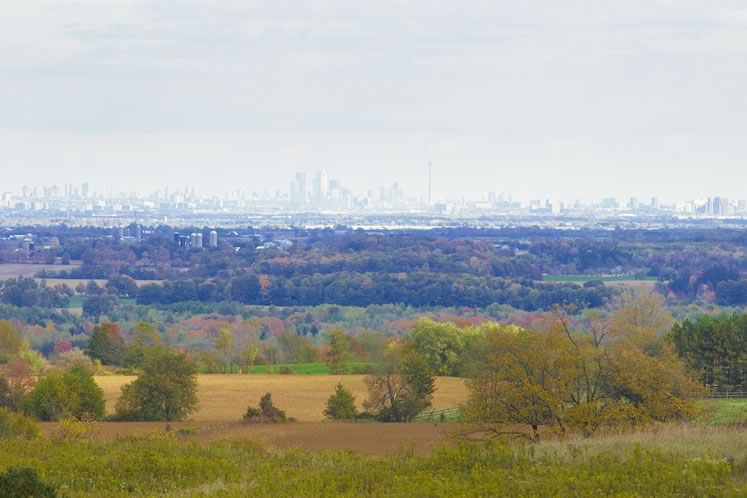
The view from Escarpment Sideroad in Caledon Headwaters is extraordinary by any global measure. Historic old Ontario villages, agrarian traditions resurging, all amid bucolic rolling hills, dramatic escarpment outcrops and the spring-fed waterways of a UNESCO World Biosphere Reserve. And all within an hour of the fourth largest city in North America. It’s hard to overstate these combined gifts. Photo by Pete Paterson.
What a miserable, blustering October night. I almost stay home. Inside Town Square Café at Caledon’s municipal offices about 30 locals mill about easels, each displaying a map of a hamlet or village. The maps show existing development as well as land designated by the Region of Peel for infilling with future growth. I sip a free coffee and peruse a scatter of images on a nearby table – sundry house styles and streetscapes.
A young planning consultant takes the podium. Warm, polished, accessible, she frames our purpose tonight: to consider Caledon’s Official Plan policies and hear suggestions for better maintaining the character of our rural neighbourhoods. Monster homes, rooflines, pedestrian traffic, and adjacent land uses are listed as possible discussion points.
Somewhere in her preamble, she uses the word “urban” to describe our historic communities. It’s a verbal clunk, but such is professional jargon sometimes. Still, this clunk soon ignites a minor firestorm as discussion opens to the floor.
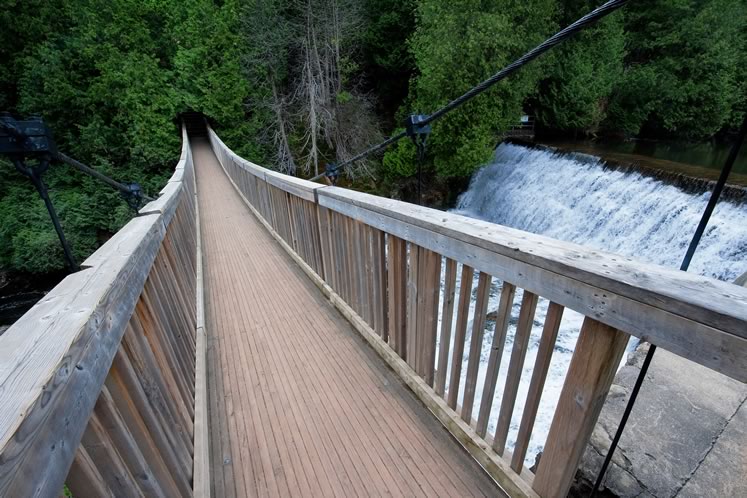
The scenic swing bridge and falls at Belfountain Conservation Area. Photo by Rosemary Hasner / Black Dog Creative Arts.
To be clear, the floor this night looks like many such town hall gatherings across Headwaters – a disproportionate number of grey heads. Those who don’t need a babysitter. Those with some free time to champion a cause. Those passionate about their longstanding roots here, couched in not a little cynicism. In short, this is not their first town hall rodeo. One such veteran takes the floor.
“I don’t want to see words like ‘urban’ used to describe our villages,” he says. His tone is cross. The word, he says, indicates how disconnected planners are from understanding our local way of life. His ensuing rant threatens to breach civility, but I get it.
As much as the presentation says all the right things about preserving heritage, there are disconnects.
Discussion points seem focused on the superficial trappings of rural and village life, aesthetics really. These are important points, but there’s no drilling down to the rhythms and rituals that constitute the heartbeat of community, and what might threaten or sustain them. These infill areas were largely drawn by Peel Region planners in the 1990s – part of the provincial growth mandate.
My focus this evening is on my nearby hamlet of Belfountain – a scenic and historic jewel on the edge of the Niagara Escarpment in the heart of Caledon. A 173-acre property on the outskirts of the village was first purchased by a developer more than 40 years ago, before the Region of Peel was incorporated, and it has passed through three owners since. Although the current owner has not officially submitted a development proposal, residents are told it’s coming – a rumoured 50 or so houses that would double the population of the village in one fell swoop. Village residents have opposed any development on the land all along, resorting to arguments about water supply and other environmental considerations, but the sticking point is really about preserving something much harder to measure – the soul of the community. How is the logic of this decades-old infill plan not open for discussion at this meeting about preserving neighbourhood character?
Indeed, the familiar North American sacred cow of inevitable growth remains the elephant in the room. We residents can rally to slow it down, even shape it in key ways, but its unquestioned priority is what we’re hearing in our neighbour’s cross tone. And he’s right – because in its path there is so much at stake.
Headwaters is extraordinary by any global measure. Historic old Ontario villages, agrarian traditions resurging, all amid bucolic, rolling hills, dramatic escarpment outcrops and the spring-fed waterways of a UNESCO World Biosphere Reserve. And all within an hour of the fourth-largest city in North America. It’s hard to overstate these combined gifts. What’s missing in this overview tonight is a deep understanding of why this place matters, how fragile all this is, and the tipping point beyond which change would disconnect us from these roots.
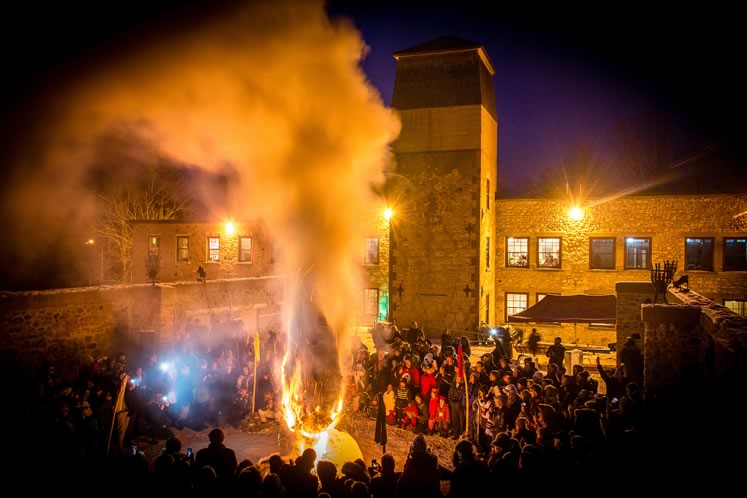
The annual Fire & Ice Festival culminates with a giant bonfire at Alton Mill Arts Centre. Courtesy Alton Mill.
Having spent a career exploring and writing about extraordinary places across this planet, I know polarized discussions like this, with similar good intentions and frustrations, are happening worldwide. On one side, local governments feel the mounting pressures of growth and the practical realities of economic sustainability. On the other, locals champion their rural heritage, fighting to protect their way of life, their connection to place. It feels like the two factions speak completely different languages.
But what if we could all speak the same language? What if our municipal governments, residents and business community all viewed our historic villages, our lifestyle and its homegrown entrepreneurs, even our protected environments, as key assets, as critical to economic sustainability? And what if, because of their value, the impact on these local assets was a primary filter for every development decision?
I happen to know parts of this globe, not so different from ours, for which this parallel universe exists. And in every case, it starts with a grassroots vision of culture and community that’s then backed fully by municipal, even national, planning priorities.
Vive la France!
Since the beginning of the 20th century, France has been the poster child for sustaining a distinct way of life amid an ever-changing world.
“I was interviewing France’s deputy minister of agriculture and I wanted to understand how France made decisions about farming and land use,” explained award-winning author and journalist Elizabeth Becker in a recent conversation. She was the international economics correspondent for the New York Times exploring globalization. After their long interview she asked the deputy minister about some maps behind him. One had thousands of red pins, one for every single cultural event in the country over the year. “What’s it for?” she asked.
The deputy minister responded, “Because everything in France becomes tourism.”
From this encounter, Becker went on to write extensively about today’s booming global tourism industry, revealing it as one of the most powerful and far-reaching economic engines of our time, for better and worse. But here’s how the French mostly get it right.
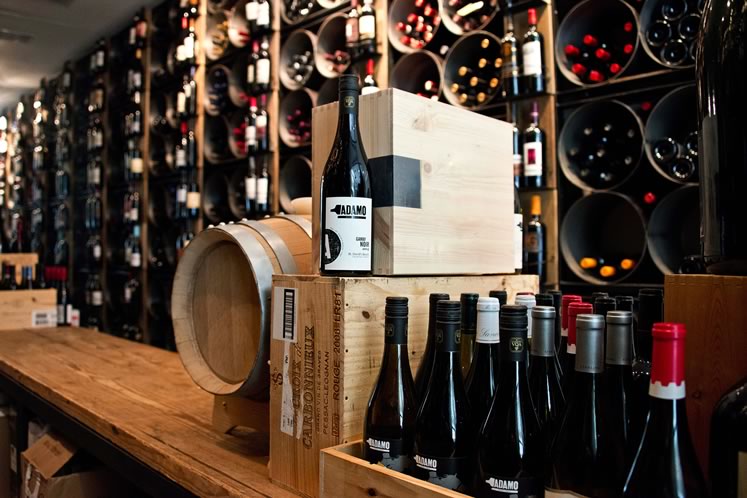
Tantalizing offerings at Adamo Estate Winery in Hockley. Photo by Pete Paterson.
From all levels of government, to business, community influencers and residents, the French are pretty much on the same page. They know in their bones what makes them special. Their vineyards, their historic towns, their ancient farming methods, their artisanal cheesemaking, even their rude Parisian waiters. With this big picture firmly intact, they protect it. They live it. They invest in it. And then they reap the benefits of the world wanting to come and share it.
Bordeaux is one of France’s more recent and dramatic examples of invest first in your people and the economic sustainability will follow. In her book Overbooked, Becker describes the city in the early ’90s as “a boring, faded beauty, its former glory hidden behind grimy buildings and abandoned warehouses.” In the late ’90s, huge investment was made to connect the Bordelais to their surrounding wine country. City centre architectural gems and the waterfront were restored to earlier splendour, celebrated in the words of Victor Hugo as “take Versailles, add Antwerp, and you have Bordeaux.” The city came alive for locals, and soon tourism dollars went from negligible to $1.4 billion per year recently, second only to the region’s famed wine industry.
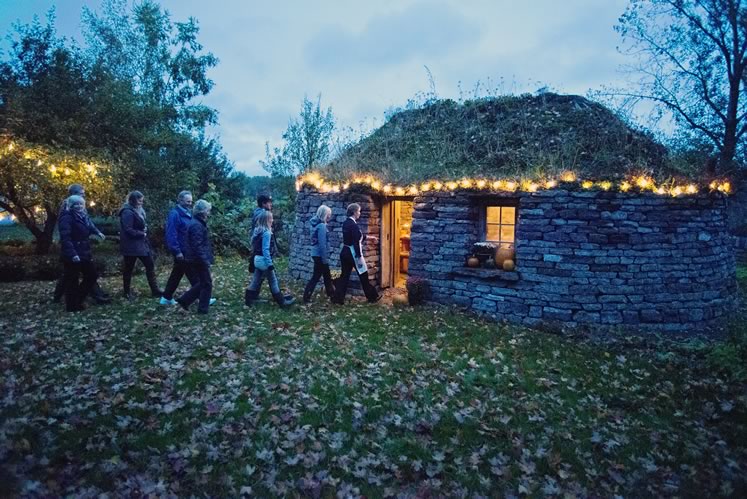
Guests arrive for dinner in The Blackhouse at Landman Gardens & Bakery near Grand Valley. Photo by Pete Paterson.
Becker paraphrases Bordeaux former deputy mayor Stephan Delaux. “He said the key to good tourism is to do your planning for the people who live there, for the citizens, and if that is done well, then the visitors will be happy.”
More than a few people in Headwaters believe this approach can work for our extraordinary corner of the world too.
Headwaters –“Where Ontario Gets Real”
Colleagues describe Headwaters Tourism CEO Michele Harris as “liquid gold” for her work defining and championing our region’s tourism brand. Recently Harris and her team’s “Where Ontario Gets Real” campaign garnered both provincial and national marketing honours, next to the likes of the iconic Newfoundland and Labrador campaigns. Driving her irrepressible enthusiasm is a vision for strengthening our communities by sharing who we are.
“To me, people in connection to place building is critical,” explains Harris. “The fight against the Melancthon mega quarry years ago galvanized all this for me. So many residents from wide-ranging backgrounds came together to protect their special part of the world – all rooted in a value system that we hold true.” It’s this common love of place and the many different ways we experience it that Harris wants to help us share.
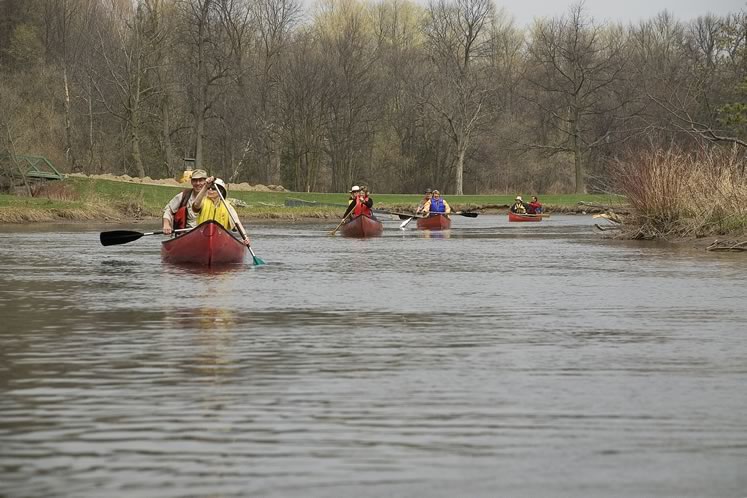
Spring on the Credit River attracts flotillas of canoes. Photo by Tom Partlett.
Check out headwaters.ca. People clearly anchor our growing brand. And no surprise, the things visitors love best here are the things we love about ourselves – our craft brewmasters, bakers and winemakers; our fresh local food growers, epicures, restaurateurs; our artists, artisans, thespians and musicians; our cyclists, equestrians, hikers, fishers and kayakers, to scratch just the surface.
In all, Harris says these locals, celebrating what locals do here, draw an estimated 875,000 visitors who spend over $68 million annually across Dufferin, Caledon and Erin.
Wow. I have to ask: Why is the potential impact on tourism not a key filter for every development decision of our municipal governments? We question water tables and other environmental impacts, all measured in the context of tax base requirements. Why not tourism? Why not take into consideration our tourism assets like our historic hamlets and rural lifestyles that inspire our local entrepreneurs?
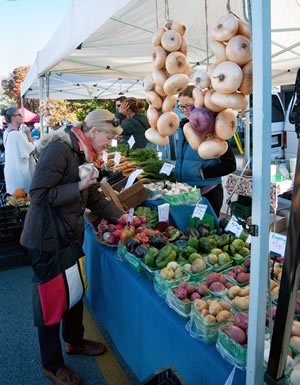
Shoppers find superb local produce on Saturdays at Orangeville Farmers’ Market. Photo by Rosemary Hasner / Black Dog Creative Arts.
Harris says even nationally and provincially, rural tourism is just starting to gel as something that can nurture both the local economy and community life. Not surprisingly, rural municipalities are playing catch up to grasp the reach and potential of tourism, from infrastructure to heritage preservation. Unlike other industries, tourism touches almost every municipal department.
Caledon now has a dedicated tourism and community development officer, a beautiful visitors’ website and a mandate to capture more tourism dollars. Still, despite attracting half of Headwaters’ tourism revenue, tourism isn’t listed among Caledon’s economic development priorities in the town’s most recent Competitive Economic Analysis Report. None of the economic development programs listed on the town website specifically target lifestyle or tourism-related industries. Planning policies are still catching up to help innovative, locally grown ventures like cideries and craft breweries get their doors open quickly and serve customers. Things may be moving in the right direction, but as with other local municipalities, tourism here is still in early days.
The biggest challenge, Harris agrees, is beyond the reach of her team. It’s not about promotion, or fostering innovative local products or experiences. They are already reaching critical mass. “What we need is everybody in each municipality, from frontline staff to planners to economic development officers and residents to all buy in,” she says.
When she meets with communities, Harris often asks, “Who do you want to be in 50 years?” She insists Headwaters tourism businesses include “many community-minded leaders who could go to their politicians and say, ‘We want to work with you to create that vision.’”
Indeed, once there’s buy-in from all players, great things are possible. Consider Costa Rica.
One Grand Vision – The Birthplace of Ecotourism
Pristine Pacific shoreline, mangroves bending to the sea and wild beaches bordered by luxuriant jungle, Corcovado National Park is a precious gem in Costa Rica’s renowned national park system.
Elizabeth Becker describes Costa Rica as the birthplace of ecotourism. Two 19th-century German naturalists were the first to catalogue a good portion of the country’s astounding biodiversity. They stayed and taught natural history to young Costa Rican students, becoming the proverbial tossed pebble with ripples that would infuse the country’s future education system and culture with a reverence for wilderness.
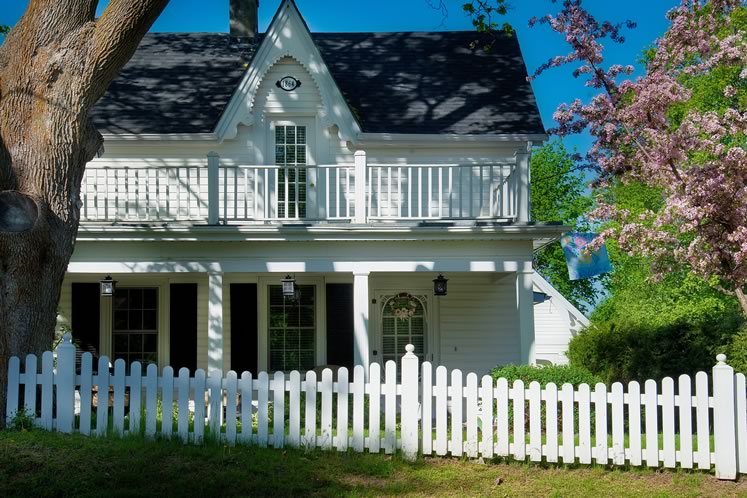
A typical century home in Inglewood, one of the region’s many vibrant and historic villages. Photo by Rosemary Hasner / Black Dog Creative Arts.
Ultimately Costa Rica became a centre of academic tropical research in Central America. As a nation they invested in a national park system and a pacifist philosophy, while neighbouring countries built armies. The 1950s marked the beginning of ecotourism proper with rustic ecolodges established near what was to become Monteverde’s Cloud Forest Biological Reserve.
Since then, these values have been tested. There was a foray into ranching in the 1980s, known as the “hamburgerization” of Costa Rica, in which forests were clear-cut for grazing land to sate North America’s appetite for fast food. Ultimately, saving the forests and attracting ecotourists proved a better bet for economic sustainability.
Through all this, government leaders and citizens doubled down on their conservationist values, and today Costa Rica continues to play a leading role in establishing global standards for ecotourism and sustainable tourism, terms that have in the past loosely peppered global tourism marketing. Of course, no path is straight, but Costa Ricans show it’s possible to protect natural treasures by making them a rallying point for government policy, culture, education and tourism.
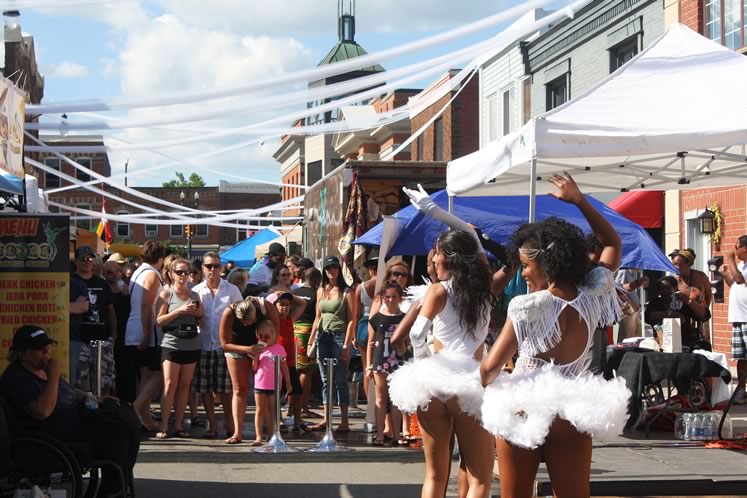
Dancers at CaribFest on the revitalized Mill Street in Orangeville. Photo by Alyssa Mahadeo.
Perhaps we can learn here from Costa Rica. Beyond our rural lifestyle gifts, running smack through the middle of Headwaters, the Niagara Escarpment is a UNESCO World Biosphere Reserve – a rarity so close to a huge city. Even still, its importance is not fully realized.
Nicola Ross is a frequent contributor to this magazine and author of the Loops & Lattes near-urban hiking guides. A resident of Belfountain, Ross has a healthy skepticism about unchecked tourism, but she also recognizes an opportunity. “We are in the Greenbelt, on the Niagara Escarpment and in the Oak Ridge’s Moraine area. We could be the outdoor green playground for the GTA. This is a vision we could build with the town.” Still, Ross says alignment with municipal economic development priorities isn’t there yet.
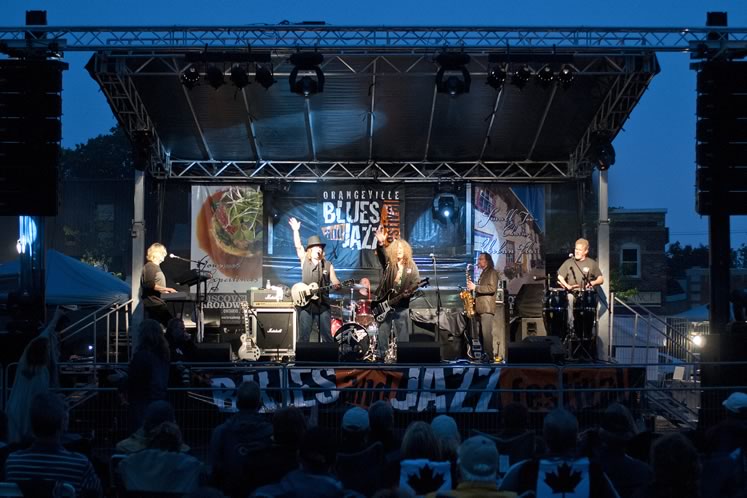
The Orangeville Blues and Jazz Festival draws more than 30,000 visitors to the town in early June. Photo by Pete Paterson.
Green entrepreneurs like Ross can be strong champions of sustainably sharing our natural spaces in ways that entrench local culture and lifestyles. As Michele Harris says, “Tourism may be the common denominator, but even more so, what such local experience entrepreneurs offer is really about building place.”
Loving Where You Live
As a travel journalist I’m asked frequently about my favourite places to go. That’s a hard one, so many possibilities. Still one answer always comes to mind. I love places that locals love to call home. To me, that’s the foundation of what Harris calls “place building.” Here’s an example and one that reminds me in many ways of what Headwaters could be a few years down the road.
After a morning pedalling Dry Creek Valley, my friend Barb and I prop up our bikes next to the tasting room at the DaVero winery and olive mill on the southwest edge of Healdsburg, Northern Sonoma. Owner Ridgely Evers is walking in from his vineyards, land he’s owned since 1982. He’s lithe, 60-something – think Ralph Lauren’s taller brother with wellies. Within minutes, this ex-software guru is deep into details about how this microclimate mirrors that of Tuscany, which is why he was the first in over 100 years to import Tuscan olive trees in the 1990s. His website says, “Grow what belongs here and be patient.” His oil is now world-renowned. His wine is a similar story – vineyards wild with a diverse undergrowth that harbours beneficial insects and enriches the soil. Everything for Evers is a story connected to place.
Down the road, pickers in this crush week stop to chat about their work here bringing in grapes from the oldest zinfandel vines in the county. Later, Forbes-celebrated restaurateur and local field-to-table wizard Dustin Valette waxes on about his realized culinary dream – a restaurant in Healdsburg in the exact building in which his French-émigré great-grandfather once operated a bakery.
A few miles north in tiny Geyserville, a storefront called Locals pours the nectar from local wineries too small to have their own tasting room. Swish local consignment clothing is displayed for perusal – vintage and vintages, of course. By the time we sip our second glass, the retired airline pilot who bottled these grapes stops by to chat. Again, it’s all about the local people sharing what they love, even their old stuff.
In Headwaters, our parallels with Sonoma extend beyond sharing a lovely, chill food culture. Both regions also grapple with the pressures of growth. Like ours, Sonoma’s 200-year-old farm community has faced unprecedented change in recent years. Half its 125 wineries are under 15 years old – a sign of their exploding tourism industry, now up to 7 million visitors a year. As with us, growing pains abound – where to expand, finding affordable housing. Still, it seems we may have the same economic potential too.
Over 80 per cent of tourism entrepreneurs who drive Sonoma’s thriving economy are small businesses. Locals own Sonoma’s evolving story, its seasonal rituals, its larger than life characters like Evers, even the Tuesday night jazz in the Healdsburg town square, where often three generations of families come early to claim their favourite spot. Agriculture, construction, craft breweries, arts, outdoor education, restaurants and specialty food – the top economic development sectors identified on the county website are a study in how government can support local lifestyle through sustainable tourism.
Even still, it’s no small challenge sharing who you are without losing who you are. Those of us who live along Forks of the Credit Road and in Belfountain understand the downside of tourism. Yet with no real plan to accommodate tourism, the numbing and worsening weekend traffic and parking congestion has had no serious consideration for more than two decades.
Managing the downside of tourism is an issue for popular sites around the world. Costa Rica’s success attracted foreign corporations that attempted to buy up pristine Costa Rican coastlines for mega resorts, and the country has been only partially successful in stemming those purchases which, among other drawbacks, send profits out of country.
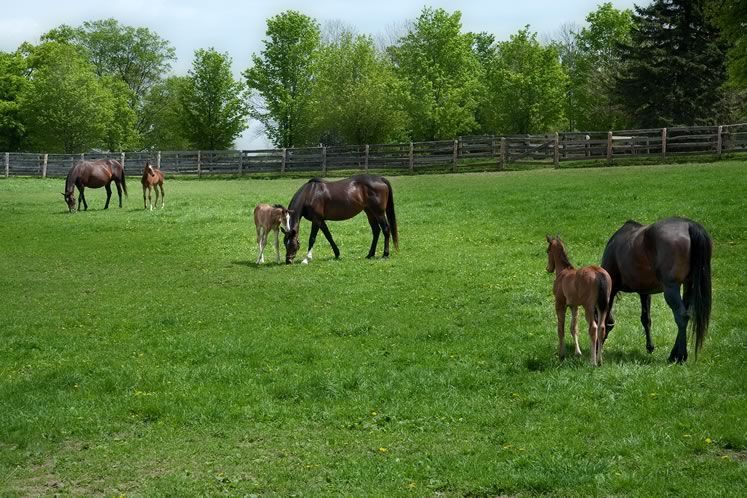
Two recent additions to Headwaters’ large equine population. Photo by Rosemary Hasner / Black Dog Creative Arts.
Elizabeth Becker shared with me her experience as a young war correspondent in the 1970s happening upon forgotten Cambodian temples deep in the jungle. Becker says Angkor Wat, the largest religious monument in the world, is today trampled by millions of tourists and exploited by mismanagement and corruption.
Social media, too, has also unleashed a seemingly insatiable appetite, along with the tools, for experiencing the world around us.
The bottom line? Tourism can do something to us or for us. Harris, Becker and others would argue that’s all the more reason communities as inviting as ours need a plan.
Owning Change
Back at the Caledon town hall meeting, it’s not just residents with a sense of déjà vu. Likely these planners and consultants have been on the receiving end of more than a few tirades about halting change. However, they also have an important truth to share. Change is not only inevitable, it’s necessary. Every vibrant living thing must change, our communities among them. (No one is pining for Belfountain’s origins as a rowdy quarry town in the early 1800s, for example.) The question is, how do we take the reins in guiding that change?
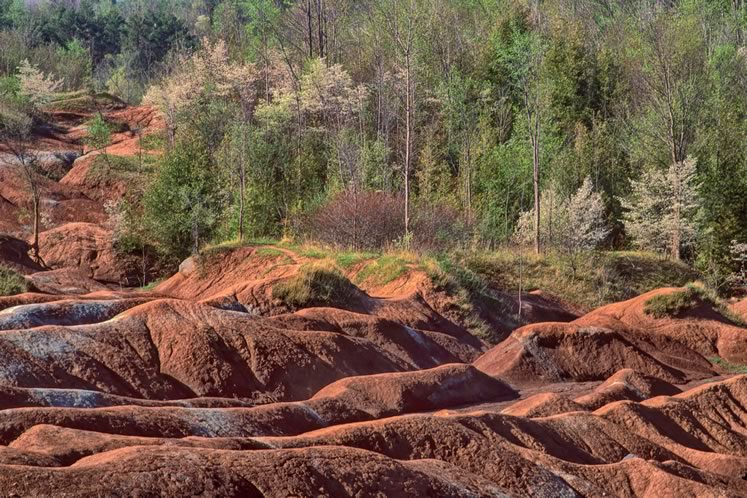
The nearby, perennially popular Cheltenham Badlands (set to reopen this summer after a three-year overhaul to accommodate tourists and protect the site). Photo by Gary Hall.
We do need to embrace new faces, new ideas and new ways of being. But we also need to protect and, together, keep connected to the things we love most about our region. For many of us, they are the very things we first ventured here to experience as tourists ourselves. “And that’s where the grassroots vision piece for community comes in,” says Harris, underscoring the need for municipal governments and citizens to align their values. “Again, who do you want to be when you grow up?”
Answering that question feels more urgent now than ever. Mounting pressure for growth guarantees that change is upon us. Still, these forces of change are not all ominous. There are also immense opportunities that didn’t exist even a decade ago. The same new technologies that have thrust globalization into warp speed also empower us to share and entrench our local lifestyles in ways more creative and more economically sustainable than ever before. It’s a challenging, but very exciting crossroads.
France, Costa Rica, Northern Sonoma and select regions around the world have much to teach us about how to move forward. Still, there’s powerful inspiration close to home too.
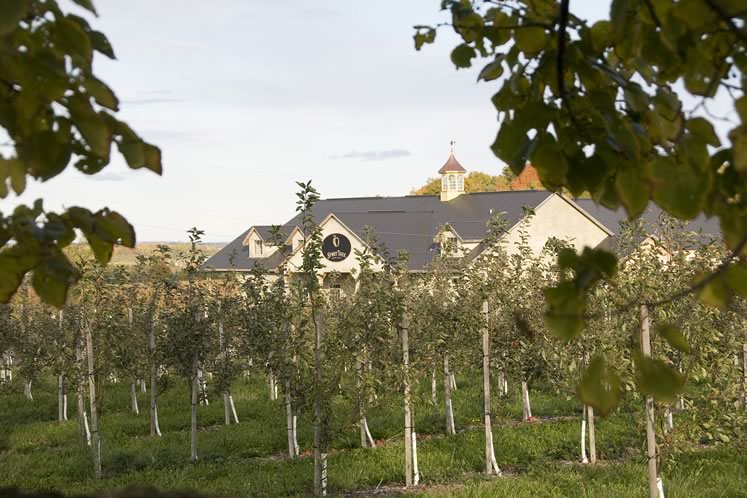
The orchards at Spirit Tree Estate Cidery in Caledon. Photo by Pete Paterson.
The theatre full of local entrepreneurs in the Town Hall Opera House rises to its feet, cheering Phil DeWar of Soulyve in Orangeville. The 2018 Headwaters Tourism Champion of the Year is a man of few words. At the podium he doesn’t boast how his spicy Caribbean fare helped transform Mill Street from a tired Orangeville laneway into a thriving food and fun hub. He doesn’t elaborate on his countless hours working with fellow business people on community events like CaribFest and Taste of Orangeville, attracting thousands of locals and visitors while celebrating the town’s growing diversity. What he does say is this: “I really love this community. This will always be my home.”
Related Stories
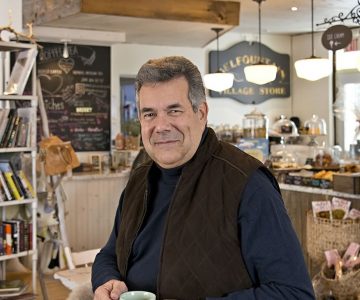
The Next Chapter at Headwaters Tourism
Mar 19, 2019 | | CommunityIndustry veteran Eduardo Lafforgue steps into the executive director role at Headwaters Tourism armed with a bold vision for the future.
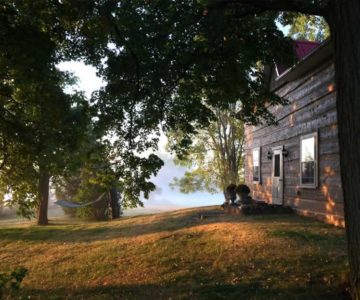
Airbnb and Other Home-sharing Companies Have Landed in Headwaters
Sep 16, 2017 | | CommunityHere’s how to find the log cabin, country estate or yurt of your dreams – for at least one night.











Thank-you for a fresh perspective on the opportunity Tourism brings to our region and the NIMBY frustrations as we tackle what we enjoy and what we are willing to sacrifice to share with day trippers.
We believe both can live in the same universe with proper strategic planning.
You can imagine my shock and dismay when I found out several years ago Mulmur Township strategic plan never mentions TOURISM in their EcDev policy. At that time they opted out of the expense of joining Headwaters Tourism initiatives.
As one of the increasing number of Tourism Initiatives of Mulmur I believe we are striving a growing in spite of the lack of interest at Town Hall up until now, and hopefully the new Mayor and council have a more progressive attitude.
Patricia Cleary Clark from Mulmur on Apr 4, 2019 at 6:56 pm |